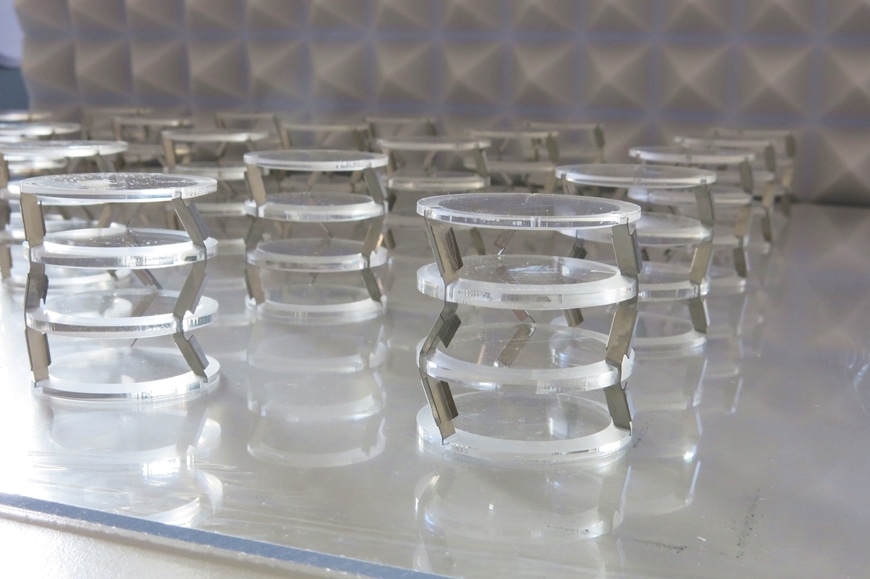Oct 15 2019
Acoustic researchers from Empa have created macroscopic crystal structures that leverage internal rotation to attenuate wave propagation. In a study published in Nature Communications, they reported that the method can produce very light and solid materials. These materials could “swallow” low frequencies quite well.
 Empa researchers developed chiral phononic crystals and built a functional model on which vibration measurements are now carried out. (Image credit: Empa)
Empa researchers developed chiral phononic crystals and built a functional model on which vibration measurements are now carried out. (Image credit: Empa)
The realm of crystals provides several intriguing properties: crystals have the ability to produce electric sparks in single-use lighters, for instance, they can emit polarized light and scatter bundled X-rays into thousands of individual reflexes refracted in all spatial directions.
A few of these properties can be maintained even when the atomic crystal structures are magnified to around 100,000,000 times and the crystals are duplicated on a large scale. For many years, physicists have exploited these properties: If the original crystals have the ability to scatter X-rays with extremely short wavelengths, then the magnified copies can scatter oscillations with long wavelengths in all directions.
Thus, a highly sophisticated technique for vibration damping has been discovered. Magnified crystal structures with such acoustic properties are known as phononic crystals.
Andrea Bergamini and his group from Empa’s Acoustics/Noise Reduction Department have now successfully combined more properties into the crystals that are absent in the originals. They incorporated tiny, rotating plates into the crystal structures to transform oscillations along the longitudinal axis into torsional movements.
It is for the first time that an unwanted oscillation has been scattered in different spatial directions as well as transformed into thermal energy.
AAAA or ABAB Arrangement
Later, Bergamini and his team combined many such rotating disks in the crystal together by either rotating all disks in the same direction (isotactic arrangement) or alternatively connecting each other with their rotational directions (syndiotactic arrangement). The effect varies drastically: the syndiotactic ABAB arrangement of the rotation direction develops what is called a frequency bandgap.
The rotation mechanism “swallows” a broad range of oscillations, which eventually do not pass through the crystal. However, the isotactic AAAA arrangement of the rotary motions produces new waves with similar frequencies, which can pass through the crystal.
Therefore, a mechanical component with specific geometry governs whether the crystal behaves as a conductor or as an insulator.
The “Cryptography Window”
How can these oscillation frequency bandgaps be used? Meanwhile, a first model that shows a probable function of phononic crystals has been created in the lab: Bergamini constructed a window from two Plexiglas plates where rotating discs in syndiotactic arrangement are joined. The disc size is adjusted to the frequency of human speech.
The concept is that when specific frequencies are filtered out of speech, the spoken subject becomes unclear to the listener. The human brain will not be able to put together the acoustic information to form a meaning.
First investigations in the acoustics lab reveal that the approach is very useful. Although it is possible to see who is talking and to hear who is talking in an imperceptible way, it is impossible to understand even a single word clearly from the spoken text.
Soundproofing Elements that are a Hundred Times Lighter?
Bergamini and his team predict that transparent, phononic crystals could attract much attention among architects and interior designers. This physical effect can produce compact building materials with a stable shape that can damp the sound very well and can be about 100 times lighter compared to other phononic insulating materials with the same effect.
In mechanical engineering, lightweight automotive construction, and aircraft construction, the elimination of interfering frequencies using lightweight designer insulating materials could play a crucial role in the near future.